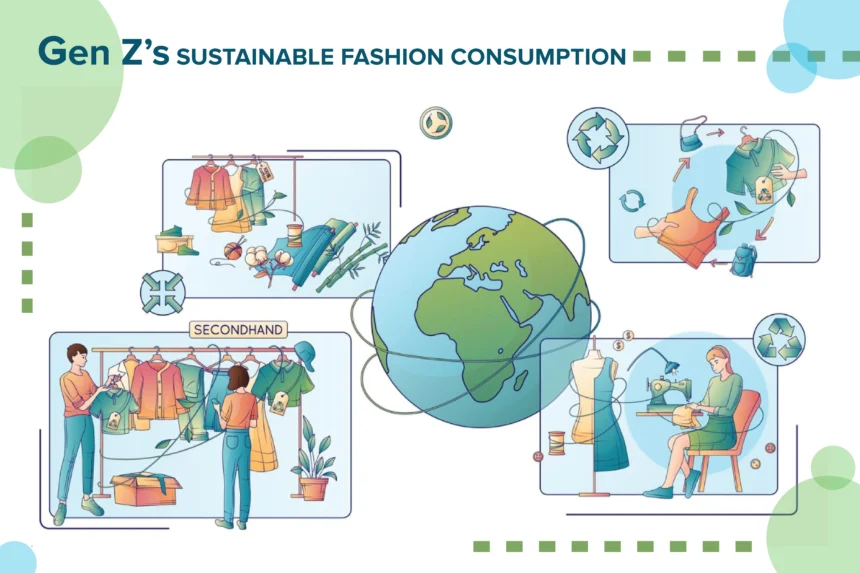From influencing industries to work pragmatism, saving and investing, ethical and sustainable consumption, work-life balancing, and more, Gen Z is setting new trends in 2025. Among all, sustainable fashion is what Gen Zs are looking for, but not really purchasing. Despite expressing a desire for sustainably produced attire, Gen Zers are fueling ultra-fast fashion, creating a sustainable-fashion conundrum.
According to McKinsey’s State of Fashion Report, despite the argument that sustainability still dominates consumer priorities and the fashion agenda, Gen Zs have a complex relationship with fashion. The sustainability expectations in Gen Z shopping contrast with their promotion of clothing “hauls” on social media. The desperate attempt to become fashion influencers and the frequent purchase of clothes are compelling them to abandon their commitment to buying sustainable fashion products.
Setting these controversial ideas apart, it has been forecasted that the global spending power of this generation will reach $12 trillion by 2030. A Forbes report highlights that Gen Zers account for around 60 million of the total US population and are gradually establishing long-term emotional relationships with brands, developing lifelong biases and preferences.
In this article, we will delve into how this generation is reshaping sustainable fashion and contributing to a movement that will dominate the future of the apparel industry. Let’s discover how.
Gen Z’s Pursuit of Sustainability is Reshaping Fashion
According to First Insight’s recent report, 62% of Gen Z shoppers prefer to purchase clothes from sustainable brands, and 73% are willing to pay more for sustainable products. Generation Z is called the “sustainable generation.” By prioritizing authenticity, sustainability, and value, the Zoomers are forcing brands to rethink loyalty.
This new generation of consumer is a new challenge for the fashion industry. They have tastes and preferences in their clothing choices that differ from the fashion look Millennials favor. Fashion trends like minimalistic styling, fitted silhouettes, tailored jackets, and athleisure are not Gen Z’s cup of tea. Unlike Millennials who want to blend with trending fashion, the Homelanders prefer to stand out from the rest. However, Gen Z and Millennials are likely to make their purchasing decisions based on social, personal, and environmental values.
Gen Z’s shopping habits are unpredictable, influenced by the continually evolving markets, unstable economies, and various crises. Despite the challenges, they want to connect with brands in a way that shares their values and lets them translate their authenticity. This tech-savvy generation tends to make fashion purchases based on thorough research or by trying clothes on physically. This shows their inclination toward making conscious shopping decisions, not only for clothes but also for all their purchases. According to a Statista report, around 35% of Gen Z avoid fast fashion globally. When talking about sustainability in fashion, it is hard to avoid discussion on fast fashion.
A Retailist report on fast fashion has revealed that fast fashion is responsible for more than 8% of the world’s global greenhouse gas emissions, contributing to the global carbon footprint. Integrating sustainability into this industry is almost impossible. The cheapness, versatility, and convenience of fast fashion comes at the cost of the use of inexpensive, petroleum-based polyester textiles, questionable labor standards, and an indifference towards wear-and-toss culture, resulting in a waste of around 92 million tons annually. While some shoppers go for fast fashion due to their inexpensiveness and versatility, many prefer embracing the “circular fashion.”
The Birth of Thrifting Fashion
Gen Z’s commitment to sustainability caused a major shift in fashion retail, the birth of thrifting. A Statista report of 2023 has shown that the global market value of secondhand and resale apparel was around $197 billion and researchers expect the industry to grow to $100 billion by 2026. Gen Zs shifted towards this trend, visiting thrift stores while buying clothes. Apart from that, they have also moved to online platforms and smartphone applications to purchase secondhand clothes.
In response, many brands and retailers are transcending to digital platforms to deliver shoppers a more accessible thrifting experience. Secondhand clothing reduces fashion waste and offers more affordable options to wear luxury fashion. Standing at the forefront of sustainable fashion, Gen Z is reshaping the way fashion is produced and consumed.
Leveraging the Power of Social Media to Promote Sustainable Purchase
Social media plays an instrumental role in magnifying Gen Z’s impact on sustainable fashion. It is not merely a platform for them; it is a space for advocacy and awareness. Today’s influencers and activists use social media platforms like TikTok, YouTube, and Instagram to emphasize the environmental and ethical issues associated with fast fashion, encouraging users to make informed choices.
With Hashtags like #SustainableFashion, #ThiftFlip, and #SlowFashion, Centennials are urging millions to adopt sustainable practices. Transparency is what Gen Z influencers demand from brands. Leveraging social media platforms, they demonstrate companies that disclose their production, sourcing, and labor practices.
Sustainable Fashion Movement: An Eco-Conscious Choice or Gen Z Dilemma
In the Gen Z sustainable fashion movement, Zoomers are promoting and often practices like upcycling, thrifting, and supporting ethical brands to reduce carbon footprints and waste. Wondering why I said “often?” Well, Gen Z’s advocacy for sustainable fashion is still at a questionable stage, where many are calling it the “sustainability paradox.” While Zoomers express a strong desire for ethical and sustainable buying, their actual purchasing behavior tells another story. The impact of fast fashion and the growing urge to stand out in the fashion parade on social media, is swaying their commitment to sustainability.
Despite the constant talk of corporate responsibility in sustainable fashion and circularity, ultra-fast fashion companies are gaining popularity, indicating a clear paradox. Gen Z consumers want to make sustainable choices, but are still reaching for trendy and cheap clothing. What could be the reason? Studies have shown that the young population is constantly under pressure to look fashionable due to social media trends like “outfit of the day” on Instagram and TikTok. Also, financial barriers are compelling them to purchase pocket-friendly and cheap apparels. Despite this, we cannot deny the influential impact of this generation in transforming the scenario of fashion retail worldwide.
With The CEO Views, we are trying to remain at the forefront of advocating positive practices like sustainable production, consumption, and more. Our articles and blogs are crafted to promote various sustainable practices along with trending industry practices to help create awareness among industry peers and other readers.










